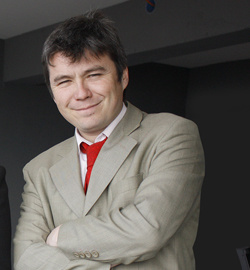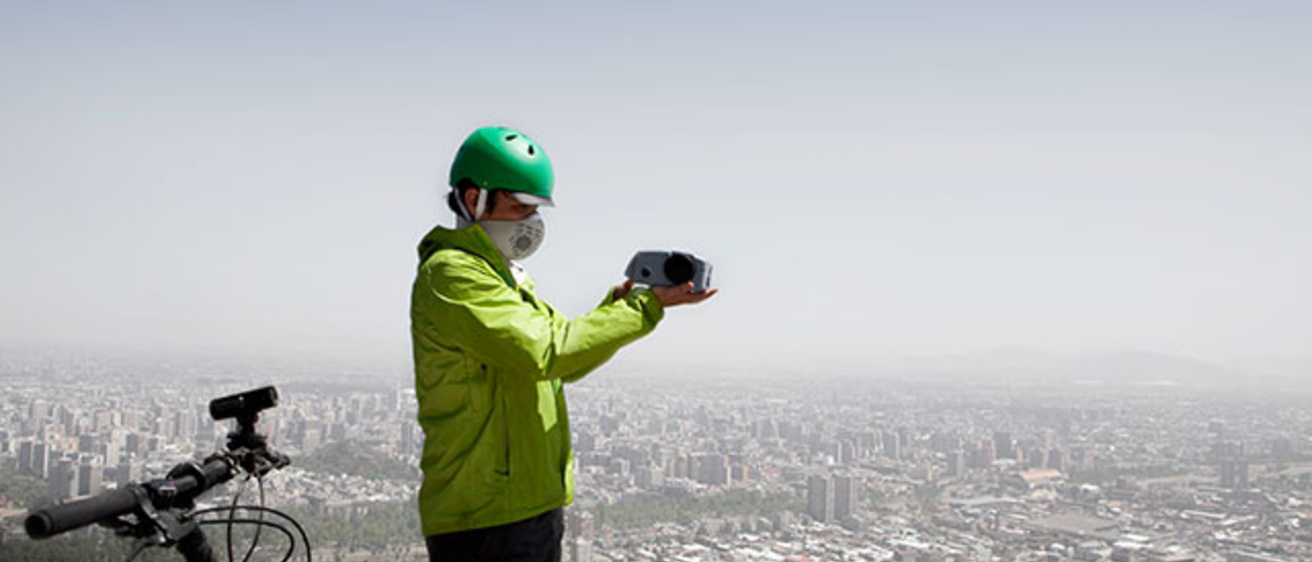Imagine that you live near a smog-filled city of six million people where, despite the best pollution prevention and forecasting efforts by city officials, residents often are mistakenly told to remain indoors on clear days and advised to go outdoors when the air is polluted.
Some of us likely would stay put and endure the conditions, while others would move away to a different city.

But University of Iowa alumnus Marcelo Mena-Carrasco chose a different path—he joined forces with University of Iowa colleagues as well as officials of the city of Santiago, Chile, to implement a dramatically improved pollution-forecasting model for the city of Santiago.
For this and other achievements, University of Iowa President Sally Mason and UI Associate Provost and Dean of International Programs Downing Thomas, will present Mena-Carrasco, currently a research center director at Universidad Nacional Andres' Bello, Santiago, Chile, with the UI’s 2013 International Impact Award at 5 p.m. Friday, Nov. 8, in the Senate Chamber of the Old Capitol Museum.
Chilean air quality czar recognized
Following the award ceremony Friday, Nov. 8, Mena-Carrasco will discuss his life and environmental work with WorldCanvass TV and radio series host Joan Kjaer on a program titled "The Social Impact of Sustainability." For more details, visit here.
The International Impact Award recognizes distinguished alumni and other individuals with significant ties to the UI who have made important contributions internationally or, in the case of international alumni, abroad in their home countries.
Established by UI International Programs in 2010, the award honors exceptional individuals in any field who have made sustained and deep contributions internationally or in the U.S. to promote global understanding. The award is presented annually during International Education Week. For more details on the week, visit here.
The idea of cleaning up the environment began during childhood, says Mena-Carrasco, who earned his master’s degree and doctorate in civil and environmental engineering from the UI College of Engineering in 2003 and 2007, respectively.
Mena-Carrasco recalls: “I grew up in Villa Alemana, Chile, (about 50 miles from Santiago) in a low-income neighborhood. I played in a creek that was polluted with trash and wastewater. I would go out on walks with my parents to find illegal trash dumping.
“One day I was near my family's summer home, in the south, walking around and found some illegal dumping,” he says. “The trash had a piece of paper. It was the scorecard of my family's card game, bearing the names of who had played. Obviously it brought home that there were environmental problems to be addressed, but also that I was in part responsible for this pollution, and we needed to take personal responsibility for our emissions.”
Notions of environmental change stayed in place as the family moved to Iowa City so that Mena-Carrasco’s father could pursue a doctorate in mathematics.
“Going to school in Iowa really was a big jump in the quality of life for my family, both direct and indirect,” he says. “I was seven years old, going to a poor public school in Chile. My dad could barely make ends meet as a young college professor with a master's degree.
“Then we went to Iowa City, moved to Hawkeye Court, then Hawkeye Drive. I went to Regina, and continued our Catholic traditions thanks to their scholarship program. I was taught English patiently by Sister Agnes. In a couple of months we were established in our communities. We enjoyed international life at Hawkeye apartments. My friends were from the United States, Sudan, Brazil, Korea, Vietnam, and China. I cherished diversity and tolerance,” he says.
After moving back to Chile, Mena-Carrasco completed his high school education and earned a bachelor’s degree in biochemical engineering. Following graduation, he worked in wastewater treatment from 1999 to 2001, a period during which Chile implemented 90 percent of its current wastewater treatment infrastructure.
When Mena-Carrasco decided to pursue a master’s degree studying water quality, he chose to study under the UI College of Engineering’s Richard Valentine, professor of civil and environmental engineering. When it was time to pursue a doctoral degree, he accepted an invitation to study air pollution with his advisor, Greg Carmichael, professor of civil and environmental engineering and co-director of the UI Center for Global and Regional Environmental Research (CGRER).
Mena-Carrasco notes that air quality forecasting models have always been powerful tools for air quality management in cities like Santiago. Air quality models remain the basis for decisions made by city officials.
“The models could be used to determine whether you could drive a car or use a wood-burning stove. So I chose to work with Greg and his team, and he really gave me opportunities that I took completely. Ten years later I was able to work with my colleagues at the University of Iowa, including Pablo Saide, and implement a forecasting model so successful that now, for the first time, we help prevent all of the extremely bad air days,” he says.
“Air quality in Santiago, despite needing much more work to be really clean, for the first time has hit a milestone of having no such bad air days. This is applied science at the service of policy,” he says.
In order to understand the air quality problems that Mena-Carrasco and his colleagues encountered in Santiago, you should know that the problems are largely seasonal in nature.
In the Southern Hemisphere, the months of April, May, and June mark the transition from summer to winter and include the phenomenon of thermal inversion, in which masses of stagnant air trapped on the ground give rise to urban air pollution.
Before Mena-Carrasco introduced the UI model, the local government would declare a Santiago air pollution episode based upon air quality forecasts conducted only 24 hours in advance. In such cases the government, by law, can temporarily restrict activities, such as manufacturing and the use of private cars, in an effort to reduce smog and protect public health.
However, by waiting until an air pollution episode was imminent, officials often acted too late to prevent even greater air quality deterioration. In short, Mena and his colleagues concluded that 24-hour forecasts needed to be replaced by the more accurate 48-hour forecasts the system can provide.
Their study was published in the May 2011 issue of the journal Atmospheric Environment. The work was led by civil and environmental engineering research assistant Pablo Saide at CGRER under the guidance of UI professor and CGRER co-director Gregory Carmichael and Scott Spak, CGRER postdoctoral researcher, with research collaborator Mena-Carrasco and others from Universidad de Chile and the U.S. National Oceanic and Atmospheric Administration.
The forecasting system itself works by accurately measuring levels of carbon monoxide, which behaves like particulate matter (PM), and using it to simulate PM. In this way, an accurate estimate of PM is made without having to conduct more difficult aerosol chemistry modeling. The new system also uses CGRER computer model simulations.
Saide says, “The system I helped to create is dynamical and based on numerical weather prediction, which provides more accurate modeling. It is able to generate a forecast several days in advance.”
The prediction system was successfully tested in 2012 by the Chilean Meteorological Office, and remains a work in progress.
"We plan to continue to work with the Chilean authorities to help them improve their air quality forecasting skill and their use of these forecasts to develop more effective emission mitigation strategies," says Carmichael.
As a result of his work on the improved air quality forecasting model, Mena-Carrasco has become well known in his home country. In July 2008, he was selected by El Mercurio magazine and the Universidad Adolfo Ibanez as one of Chile's 100 leaders. Subsequently, he served as advisor to the director of CONAMA, Chile's environmental protection agency, and to the minister of environment where Mena-Carrasco serves as “air quality czar.”
In 2012, he served as energy and climate specialist for Fundacion Chile, a private, nonprofit corporation aimed at enhancing Chile’s global competitiveness. Also, he considered running for a seat in the Chilean Senate, but decided against it, in part, because of the success he has enjoyed in influencing policy through the news media. Since returning to Chile, he estimates he has written about 50 op-ed pieces in national papers or magazines and has appeared on TV more than 100 times, speaking on various environmental issues, ranging from the effects of second-hand cigarette smoke to indoor air quality, with some success.
“For example,” he says, “we pointed out that kerosene space heaters are really bad for indoor air quality. The government can either take a regulatory approach and try to control their emissions, or I can do a five-minute report on national TV that shows that living in a place that has a space heater is worse than living in a tailpipe of a car. This last report caused sales to drop for space heaters by 50 percent. That result is faster than any government-mandated measure, I think.”
Today, Mena-Carrasco lives in Santiago with his wife, who has a master’s degree in urban planning, a son, 8, a daughter, 6, and a two-month-old daughter. He directs the Department of Environmental Engineering and the Center for Sustainability Research at the Universidad Nacional Andres' Bello, one of the largest and most prestigious private universities in Chile.
In roughly a year, his department's opinion pieces and work on sustainable design, biofuels, renewable energy, air pollution modeling, and energy efficiency transformed the group into one of the most visible departments in Chile. Student enrollment rose 67 percent in one year.
On the occasion of his receiving a 2013 Distinguished Alumni Award from the UI Alumni Association, Mena-Carrasco was described as someone who “possesses the rare ability to translate engineering research into improved public policy.”
Perhaps the most fitting description of Mena-Carrasco’s engineering and public policy acumen is found In UI College of Engineering Dean Alec Scranton's letter of nomination for the International Impact Award: “While most engineers focus on identifying and solving technical problems and leave social and political activism to others, Marcelo Mena-Carrasco is not among them. For Dr. Mena-Carrasco, the solution of environmental problems through improved technology is inextricably related to the solution of social problems through the enhancement of social capital. Dr. Mena-Carrasco believes the applied sciences have a considerable impact on society, and therefore on public policy, and that the reverse is also true.”
